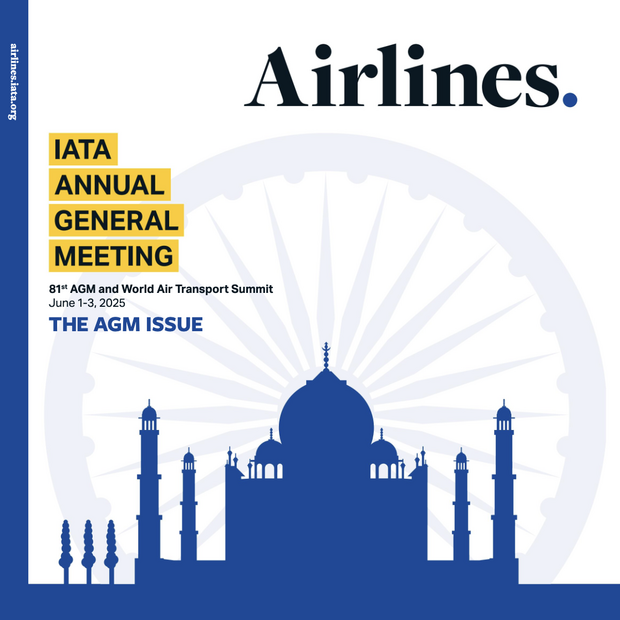
Translations: 国际航协:4月客运需求增长8% (pdf)
La demanda de pasajeros aéreos crece 8% en abril (pdf)
Croissance accélérée de 8 % du trafic de passagers en avril (pdf)
(pdf) الطلب على السفر الجوي ينمو بنسبة 8% في شهر أبريل
Geneva - The International Air Transport Association (IATA) released data for April 2025 global passenger demand with the following highlights:
- Total demand, measured in revenue passenger kilometers (RPK), was up 8.0% compared to April 2024. Total capacity, measured in available seat kilometers (ASK), was up 6.5% year-on-year. The April load factor was 83.6% (+1.1 ppt compared to April 2024).
- International demand rose 10.8% compared to April 2024. Capacity was up 8.5% year-on-year, and the load factor was 84.1% (+1.7 ppt compared to April 2024), the highest ever for April.
- Domestic demand increased 3.3% compared to April 2024. Capacity was up 3.1% year-on-year. The load factor was 82.7% (+0.1 ppt compared to April 2024).
“April was a positive month for travel. Growth strengthened, especially for international demand which saw record load factors for the month. The return of the transatlantic market to growth is particularly encouraging. But there are some signs of fragility of consumer and business confidence with continued weakness in the US domestic market and a sharp fall in North American premium class travel,” said Willie Walsh, IATA’s Director General.
“As we gather in New Delhi, India for the 81st IATA Annual General Meeting and World Air Transport Summit, it is notable that Indian domestic growth is running at over 10%. The development of India’s air connectivity in recent years has been nothing short of phenomenal, making this year’s gathering a timely and powerful reminder for all on how aviation connectivity drives growth and development,” said Walsh.
Air Passenger Market in Detail
| April 2025 (% year-on-year) | World Share1 | RPK | ASK | PLF(%-PT)2 | PLF(Level)3 |
|---|---|---|---|---|---|
| Total Market | 100% | 8.0% | 6.5% | 1.1% | 83.6% |
| Africa | 2.2% | 14.2% | 10.3% | 2.6% | 76.3% |
| Asia Pacific | 33.5% | 10.6% | 7.9% | 2.0% | 84.4% |
| Europe | 26.7% | 8.3% | 6.6% | 1.3% | 85.1% |
| Latin America | 5.3% | 10.9% | 10.1% | 0.6% | 82.3% |
| Middle East | 9.4% | 11.3% | 6.7% | 3.4% | 82.9% |
| North America | 22.9% | 1.6% | 3.2% | -1.3% | 81.9% |
1) % of industry RPK in 2024 2) Year-on-year change in load factor 3) Load Factor Level
Regional Breakdown - International Passenger Markets
International RPK growth accelerated to 10.8% in April year-on-year, with growth in all regions and load factors increasing everywhere except a slight fall in Latin America. Africa resumed growth after two months of declines, and North American international RPK grew (+5.4%), but suffered a 26% fall in First and Business class travel.
Asia-Pacific airlines achieved a 14.4% year-on-year increase in demand. Capacity increased 12.7% year-on-year and the load factor was 85.3% (+1.3 ppt compared to April 2024).
European carriers had a 9.4% year-on-year increase in demand. Capacity increased 7.7% year-on-year, and the load factor was 84.5% (+1.3 ppt compared to April 2024).
Middle Eastern carriers saw an 11.2% year-on-year increase in demand. Capacity increased 6.6% year-on-year and the load factor was 83.1% (+3.4 ppt compared to April 2024).
North American carriers saw a 5.4% year-on-year increase in demand. Capacity increased 2.6% year-on-year, and the load factor was 83.4% (+2.2 ppt compared to April 2024).
Latin American airlines saw a 13.9% year-on-year increase in demand. Capacity climbed 14.6% year-on-year. The load factor was 83.2% (-0.6 ppt compared to April 2024).
African airlines saw a 13.6% year-on-year increase in demand. Capacity was up 8.9% year-on-year. The load factor was 76.3% (+3.1 ppt compared to April 2024).
Domestic Passenger Markets
Domestic RPK rose 3.3% over April 2024 and load factor increased just 0.1ppt to 82.7% on the back of 3.1% capacity expansion. Domestic US traffic was the only market to contract (-0.5%) for a third straight month of decline, while India and Brazil expanded at a double-digit pace. India’s capacity expansion was even faster, leading to a slight fall in load factor, but its PLF is still the highest of the major domestic markets.
| April 2025 (% year-on-year) | World Share1 | RPK | ASK | PLF(%-PT)2 | PLF(LEVEL)3 |
|---|---|---|---|---|---|
| Domestic | 38.2% | 3.3% | 3.1% | 0.1% | 82.7% |
| Domestic Australia | 0.8% | 2.4% | -2.2% | 3.7% | 81.5% |
| Domestic Brazil | 1.1% | 13.5% | 7.7% | 4.2% | 81.1% |
| Domestic China P.R. | 11.3% | 7.0% | 3.7% | 2.6% | 83.9% |
| Domestic India | 1.6% | 10.1% | 11.3% | -0.9% | 85.7% |
| Domestic Japan | 1.0% | 7.3% | 2.3% | 3.4% | 73.6% |
| Domestic US | 14.4% | -0.5% | 3.4% | -3.1% | 80.6% |
1) % of industry RPK in 2024 2) year-on-year change in load factor 3) Load Factor Level
Note: the six domestic passenger markets for which broken-down data are available account for approximately 30.2% of global total RPKs and 79.1% of total domestic RPKs.
> View the April 2025 Air Passenger Market Analysis (pdf)
For more information, please contact:
Corporate Communications
Tel: +41 22 770 2967
Email: corpcomms@iata.org
Notes for Editors:
- IATA (International Air Transport Association) represents some 360 airlines comprising over 80% of global air traffic.
- You can follow us on X for announcements, policy positions, and other useful industry information.
- Fly Net Zero
- Statistics compiled by IATA Economics using direct airline reporting complemented by estimates, including the use of FlightRadar24 data provided under license.
- All figures are provisional and represent total reporting at time of publication plus estimates for missing data. Historic figures are subject to revision.
- Domestic RPKs accounted for about 38.2% of the total market in 2024. The six domestic markets in this report account for 30.2% of global RPKs.
- Explanation of measurement terms:
- RPK: Revenue Passenger Kilometers measures actual passenger traffic
- ASK: Available Seat Kilometers measures available passenger capacity
- PLF: Passenger Load Factor is % of ASKs used.
- IATA statistics cover international and domestic scheduled air traffic for IATA member and non-member airlines.
- Total passenger traffic market shares by region of carriers for 2024 in terms of RPK are: Asia-Pacific 33.5%, Europe 26.7%, North America 22.9%, Middle East 9.4%, Latin America 5.3%, and Africa 2.2%.

